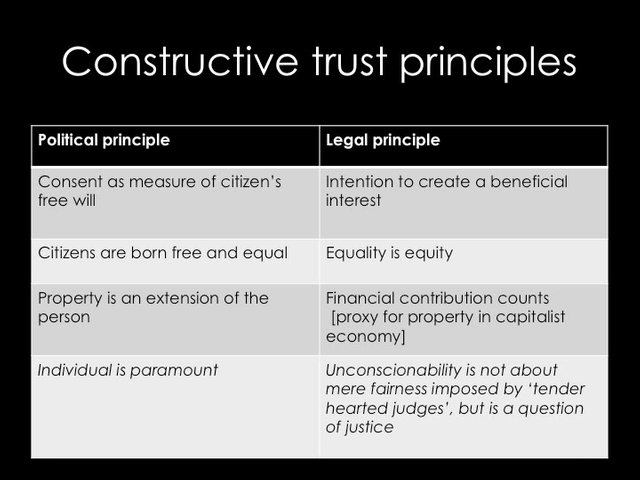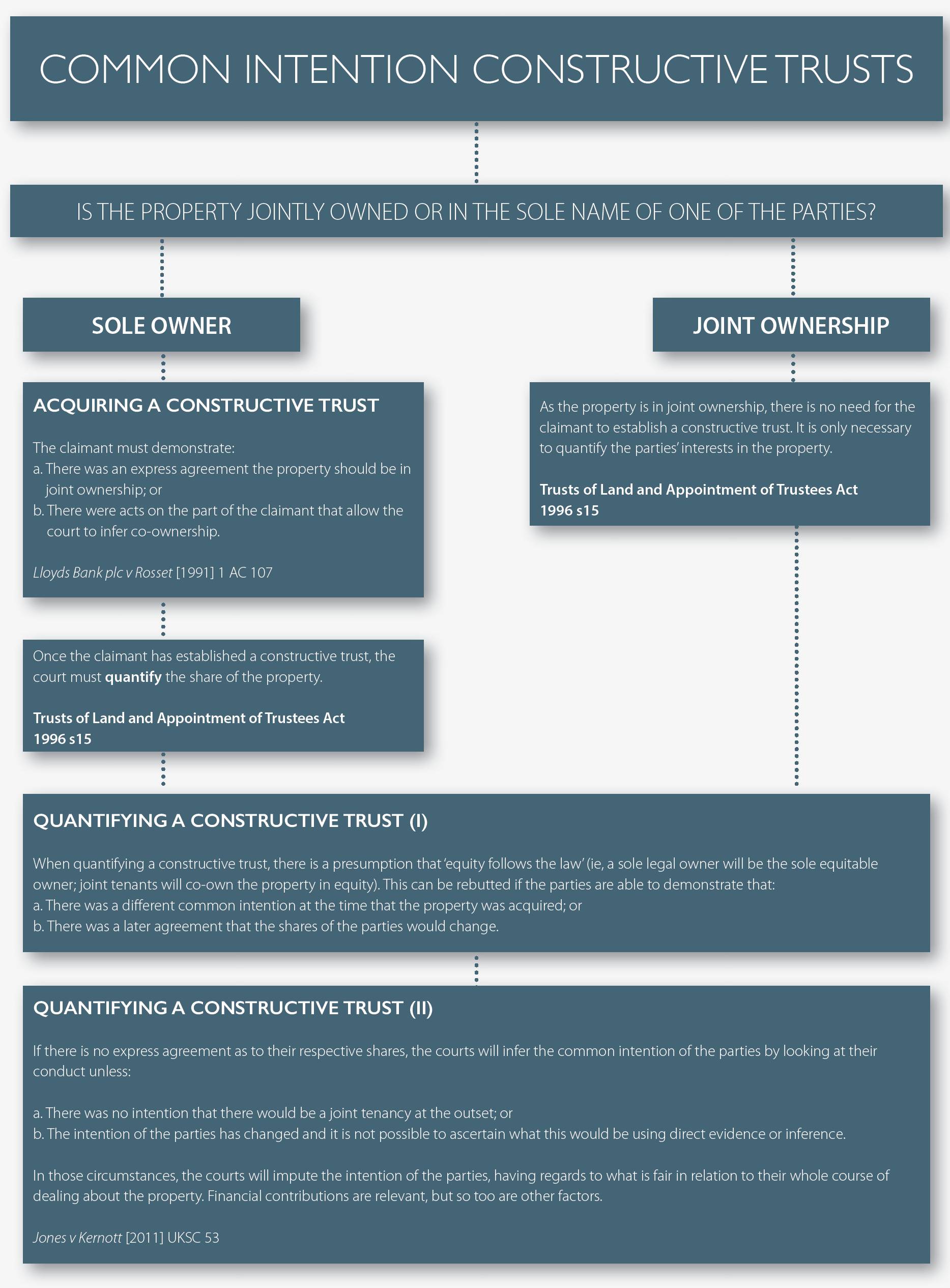Revealing the Advantages of a Useful Rely On Managing Beneficiary Conflicts
The concept of a constructive trust becomes a critical tool in the elaborate world of recipient disputes, supplying a nuanced remedy to disputes that frequently develop from wrongful home retention. By promoting a fiduciary connection between celebrations, this equitable remedy not only helps with swift resolutions but also serves to discourage prospective misbehavior. As we discover the complex benefits of positive depends on, one may start to question how these mechanisms can improve the landscape of estate conflicts and contribute to a much more equitable distribution of properties amongst beneficiaries.
Definition of Constructive Trust
A constructive count on is regularly developed by courts to attend to situations where one party has actually wrongfully gotten or maintained residential property that truly belongs to another (What Is A Constructive Trust). This lawful idea is not a conventional count on, as it does not require the procedures generally related to trust fund production, such as a composed contract or the intention of the celebrations entailed. Instead, a positive count on emerges by operation of regulation, functioning as a fair treatment to avoid unfair enrichment
The courts impose a positive count on when it is established that a person event holds building under situations that, in equity and excellent conscience, need to not permit them to maintain it. Common circumstances involve deceitful actions, breaches of fiduciary duty, or situations where an event has gotten residential or commercial property via improper ways. The positive trust thus works to shield the rights of the rightful owner by making certain that the residential property is held for their benefit.
When developed, the useful trust fund calls for the party in ownership of the property to convey it to the rightful proprietor, thus fixing the wrongful situation. This system emphasizes the legal system's dedication to justness and justice in residential or commercial property disagreements, stressing the importance of honest conduct in possession and transfer of assets.
Benefits of Positive Trusts
Constructive depends on use a number of substantial advantages in legal disputes entailing property rights. Mainly, they offer as a fair remedy, enabling courts to deal with situations where a party has actually wrongfully acquired or kept home that rightfully belongs to another. This develops a structure for fairness, ensuring that the rightful owner is made up and the unjustified enrichment of the offender is curtailed.
In addition, positive depends on can accelerate resolution in disputes over estate possessions, thus reducing the often controversial and prolonged lawsuits procedures connected with standard property disagreements. Their adaptability enables courts to tailor treatments to fit the particular situations of each case, which can cause more adequate results for all celebrations involved.
Additionally, positive depends on advertise openness and accountability among fiduciaries and beneficiaries, as they need the last to act in the most effective interests of the former. This reinforces the integrity of fiduciary partnerships, promoting trust and cooperation. By discouraging misconduct associated to property ownership, constructive counts on contribute to the general stability of monetary and legal systems, making sure that building civil liberties are respected and upheld within society.
How Constructive Trusts Job

In technique, when a positive trust fund is enforced, the court recognizes the property in question and develops a fiduciary partnership in between the celebrations included. The celebration who holds the home ends up being a trustee, obligated to manage it for the benefit of the rightful proprietor, recognized as the recipient. This connection is not based on a formal arrangement yet instead on the principle of equity, aiming to rectify scenarios where one party's gain directly correlates with another's loss.

Case Researches and Instances
When analyzing the practical application of positive depends on, different case researches find out show how courts browse complicated situations involving unjustified enrichment. One significant situation is * Pettkus v. Becker *, where the High Court of copyright established a constructive trust fund to remedy the unjust enrichment of one event over one more in a long-term connection. The court identified that the payments of one partner to the acquisition of building warranted the charge of a constructive depend on, guaranteeing fair distribution.
One more significant instance is * Gisborne v. Gisborne *, where the court imposed a positive count on to resolve the insurance claims of brother or sisters over their departed bro's estate. The court recognized the payments made by the siblings in preserving the family members home, leading to a decision that called for the estate to represent those payments, thus stopping unjustified enrichment.
These cases exemplify just how constructive counts on can successfully resolve disputes by concentrating on justness and the avoidance of unjust enrichment. By analyzing the certain payments and circumstances of the parties involved, courts can apply positive depend achieve just results, eventually strengthening the fair concepts underpinning these lawful mechanisms.

Actions to Develop a Useful Trust Fund
To establish a useful trust fund, several crucial actions need to be complied with to ensure that the insurance claim is confirmed and legally acknowledged. The complaintant must demonstrate the existence of a fiduciary connection or a scenario that warrants the imposition of a useful trust fund, such as fraudulence, unjust enrichment, or a breach of duty.
Second, it is important to collect and existing engaging evidence that supports the claim. This includes documentation and testimonies that illustrate the scenarios causing the claimed wrongful retention of property or benefits by the trustee.
Third, the claimant ought to file a petition in the appropriate court, articulating the premises for asking for the charge of a useful count on. This petition should outline the specifics of the relationship and the unjust enrichment that necessitates the trust fund.
Verdict
In conclusion, useful linked here trust funds represent a vital equitable treatment in the world of recipient conflicts, successfully resolving wrongful home retention and stopping unjust enrichment. Inevitably, useful trust funds promote fairness among beneficiaries, making certain that rightful ownership is maintained and shielded.
A useful depend on is regularly established by courts to attend to scenarios where one event has wrongfully acquired or maintained property that rightfully belongs to one more.The courts impose a useful trust fund when it is determined that one party holds home under conditions that, in equity and good conscience, must not allow them to retain it. By discouraging misconduct related to building ownership, useful depends on add to the overall security of economic and lawful systems, guaranteeing that residential property civil liberties are respected and promoted within culture.
In method, when a constructive count on is imposed, the court recognizes the building in concern and establishes a fiduciary relationship in between the celebrations involved. What Is A Constructive Trust. The court established that the payments of one partner to the procurement of building validated the imposition of a positive depend on, making sure equitable circulation
Comments on “Essential Information About What Is A Constructive Trust and Its Uses”